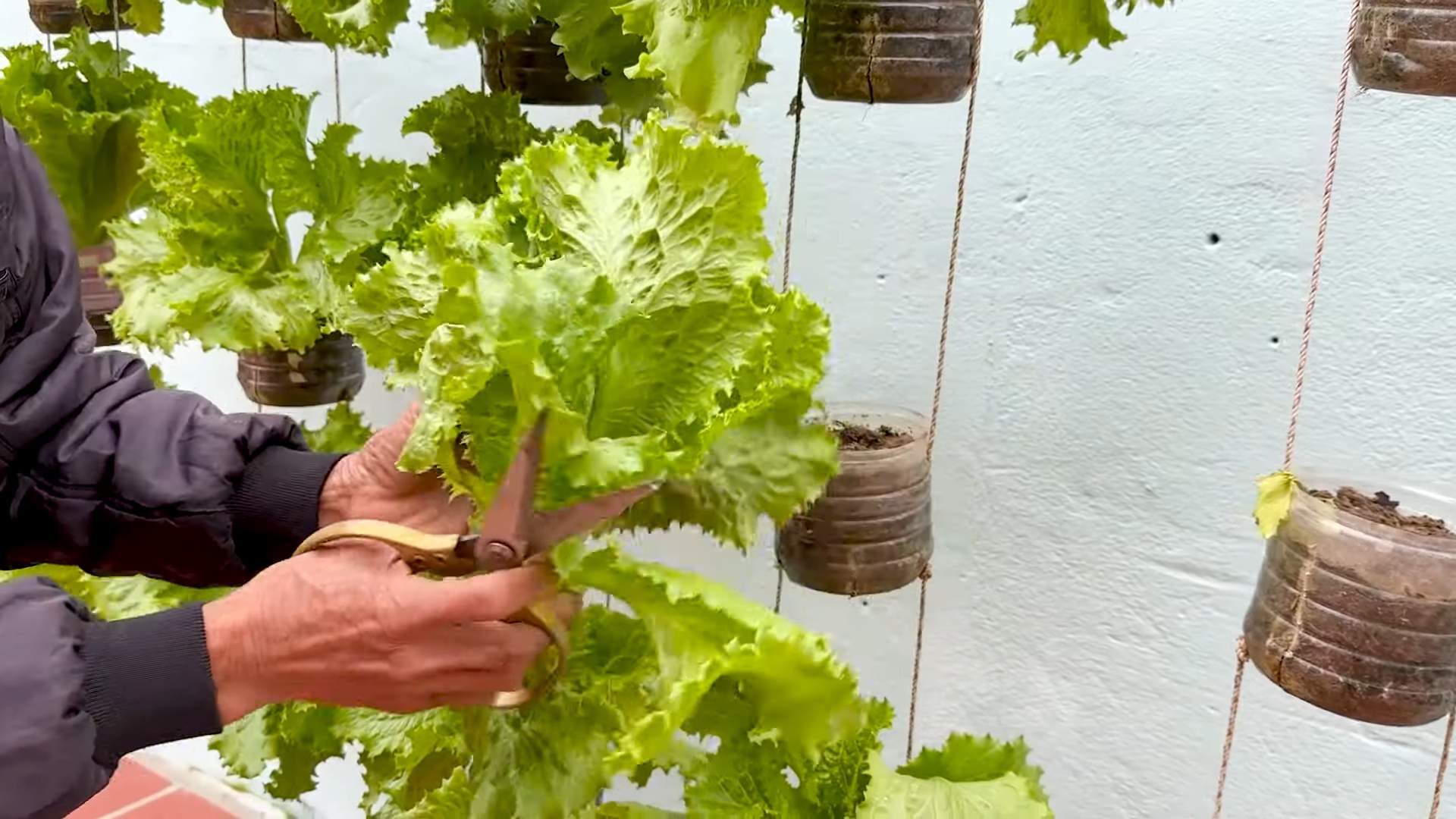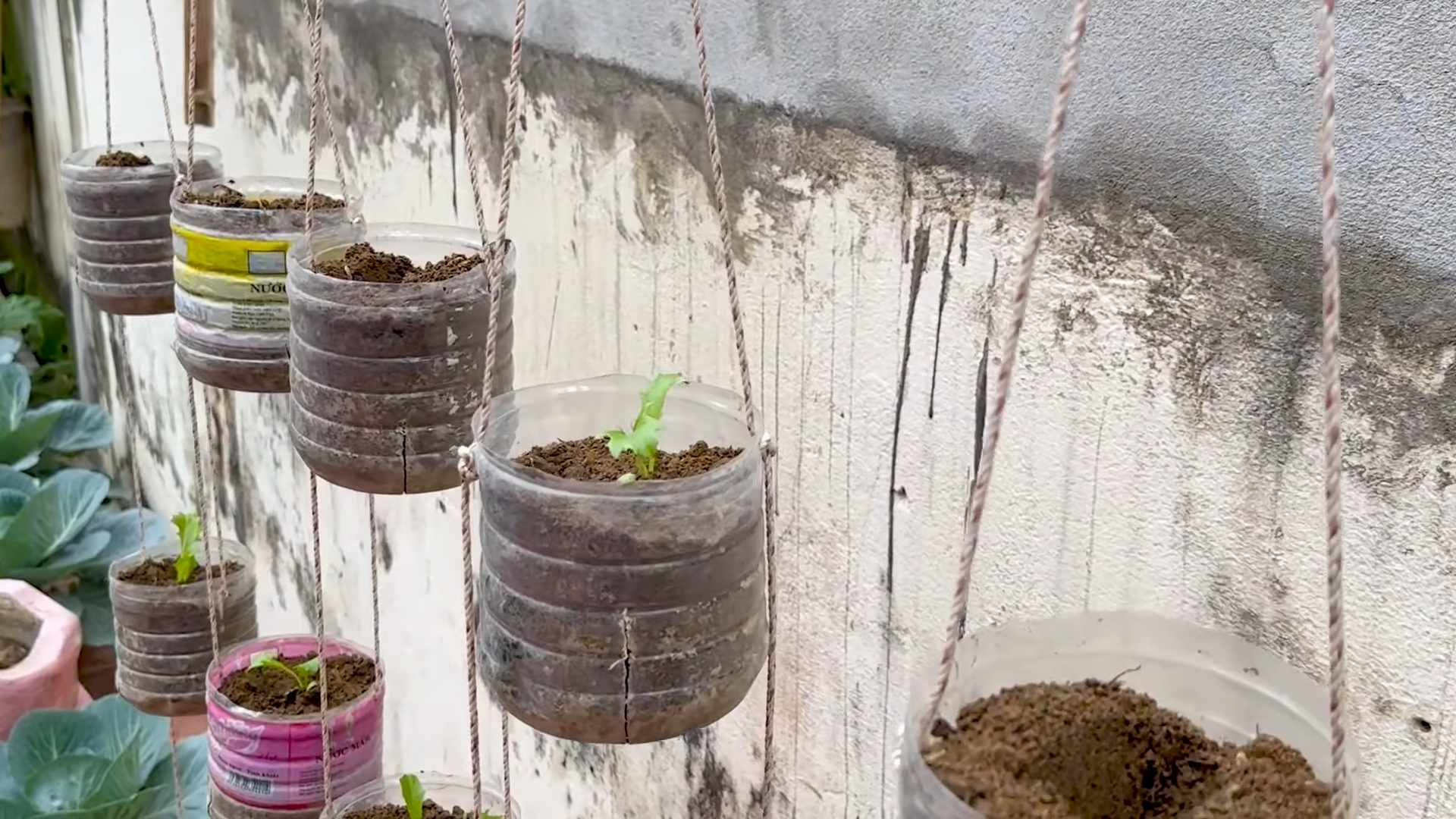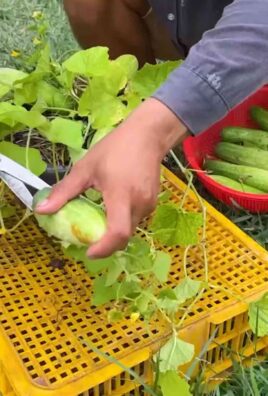Growing Lettuce at Home is easier than you think, and I’m here to show you how! Forget those limp, overpriced heads of lettuce at the grocery store. Imagine stepping into your backyard or even just reaching for a pot on your windowsill and harvesting fresh, crisp lettuce whenever you want. Sounds dreamy, right?
For centuries, cultivating your own food has been a cornerstone of self-sufficiency and a connection to nature. From ancient Roman gardens to the victory gardens of World War II, growing your own greens has always been a way to ensure fresh, healthy food is available. And while large-scale agriculture has its place, there’s something incredibly satisfying about nurturing a plant from seed to salad.
But let’s be honest, not everyone has a green thumb, or the time to dedicate to complicated gardening techniques. That’s where these simple DIY tricks and hacks come in! I’m going to share some of my favorite tips for growing lettuce at home, even if you’re a complete beginner. We’ll cover everything from choosing the right varieties to maximizing your harvest, all with minimal effort and maximum reward. So, ditch the store-bought lettuce and let’s get growing!

Growing Lettuce at Home: A Beginner’s Guide
Hey there, fellow gardening enthusiasts! I’m so excited to share my experience with growing lettuce at home. It’s surprisingly easy, incredibly rewarding, and nothing beats the taste of fresh, homegrown lettuce in your salads. This guide will walk you through everything you need to know, from choosing the right lettuce variety to harvesting your leafy greens. Let’s get started!
Choosing Your Lettuce Variety
Before you even think about planting, you need to decide what kind of lettuce you want to grow. There are four main types:
* **Loose-leaf:** This is the easiest type to grow and harvest. The leaves grow in a bunch, and you can pick them as needed without pulling up the whole plant. Popular varieties include Black Seeded Simpson, Red Sails, and Oak Leaf.
* **Butterhead:** These lettuces form loose heads with soft, buttery leaves. They’re known for their delicate flavor and texture. Look for varieties like Buttercrunch and Bibb.
* **Romaine:** Romaine lettuces have long, upright leaves that form a loose head. They’re crisp and sturdy, making them perfect for salads and sandwiches. Popular varieties include Parris Island Cos and Jericho.
* **Crisphead:** These lettuces form tight, round heads, like iceberg lettuce. They’re the most challenging to grow and require consistent watering and cool temperatures. I’d recommend starting with one of the other types if you’re a beginner.
I personally love growing loose-leaf varieties because they’re so easy to harvest and keep producing throughout the season.
Getting Started: Seeds or Seedlings?
You have two options for starting your lettuce: seeds or seedlings.
* **Seeds:** Starting from seed is more economical and gives you a wider variety of choices. However, it requires a bit more patience and attention.
* **Seedlings:** Buying seedlings from a nursery or garden center is a quicker and easier option, especially if you’re short on time or space.
I usually start my lettuce from seed indoors, about 4-6 weeks before the last expected frost. This gives them a head start and allows me to control the growing conditions.
Planting Your Lettuce
Whether you’re starting from seed or seedlings, here’s how to plant your lettuce:
Planting from Seed Indoors:
1. **Gather your supplies:** You’ll need seed starting trays or small pots, seed starting mix, lettuce seeds, a spray bottle, and a warm, sunny location or grow lights.
2. **Fill the trays or pots with seed starting mix:** Gently moisten the mix with the spray bottle. You want it damp, but not soggy.
3. **Sow the seeds:** Sprinkle a few seeds into each cell or pot. Lettuce seeds are small, so don’t bury them too deep. About 1/4 inch is perfect.
4. **Cover the seeds lightly with seed starting mix:** Gently pat the mix down.
5. **Water the seeds:** Use the spray bottle to mist the surface of the soil.
6. **Provide warmth and light:** Place the trays or pots in a warm, sunny location or under grow lights. If using grow lights, keep them on for about 14-16 hours per day.
7. **Keep the soil moist:** Check the soil daily and water as needed to keep it consistently moist.
8. **Thin the seedlings:** Once the seedlings have their first true leaves (the second set of leaves), thin them out so that only one strong seedling remains in each cell or pot.
Planting Seedlings Outdoors:
1. **Choose a sunny location:** Lettuce needs at least 6 hours of sunlight per day.
2. **Prepare the soil:** Lettuce prefers well-drained soil that is rich in organic matter. Amend the soil with compost or aged manure before planting.
3. **Harden off the seedlings:** Before transplanting your seedlings outdoors, you need to harden them off. This means gradually exposing them to outdoor conditions over a period of about a week. Start by placing them in a sheltered location for a few hours each day, gradually increasing the amount of time they spend outdoors.
4. **Dig holes:** Dig holes that are slightly larger than the root balls of the seedlings. Space the holes about 6-12 inches apart, depending on the variety of lettuce you’re growing.
5. **Remove the seedlings from their containers:** Gently remove the seedlings from their containers, being careful not to damage the roots.
6. **Place the seedlings in the holes:** Place the seedlings in the holes and backfill with soil. Gently pat the soil down around the base of the plants.
7. **Water the seedlings:** Water the seedlings thoroughly after planting.
Planting Seeds Directly Outdoors:
1. **Prepare the soil:** As with seedlings, lettuce prefers well-drained soil rich in organic matter. Amend the soil with compost or aged manure.
2. **Sow the seeds:** Sow the seeds about 1/4 inch deep and 1 inch apart in rows.
3. **Water the seeds:** Gently water the seeds.
4. **Thin the seedlings:** Once the seedlings emerge and have their first true leaves, thin them to 6-12 inches apart, depending on the variety.
Caring for Your Lettuce
Once your lettuce is planted, here’s how to keep it healthy and thriving:
* **Watering:** Lettuce needs consistent moisture, especially during hot weather. Water deeply whenever the top inch of soil feels dry. Avoid overhead watering, as this can lead to fungal diseases.
* **Fertilizing:** Lettuce is a light feeder, but it will benefit from a side dressing of compost or a balanced fertilizer every few weeks.
* **Weeding:** Keep the area around your lettuce plants free of weeds. Weeds compete with lettuce for water and nutrients.
* **Pest control:** Lettuce is susceptible to a few common pests, such as aphids, slugs, and snails. Check your plants regularly for signs of infestation and take action as needed. I’ve found that a simple solution of soapy water can be effective against aphids. For slugs and snails, try using beer traps or handpicking them off the plants.
* **Bolting:** Bolting is when lettuce plants send up a flower stalk and the leaves become bitter. This usually happens in hot weather. To prevent bolting, choose heat-tolerant varieties, provide shade during the hottest part of the day, and water regularly. If your lettuce does bolt, you can still harvest the leaves, but they may not taste as good.
Harvesting Your Lettuce
Harvesting lettuce is the best part! You can start harvesting loose-leaf lettuce as soon as the leaves are big enough to eat. Simply snip off the outer leaves with scissors or a knife, leaving the inner leaves to continue growing. For butterhead and romaine lettuces, you can harvest the entire head when it’s mature. Crisphead lettuces are ready to harvest when the head is firm and round.
Here’s a breakdown of harvesting each type:
* **Loose-leaf:** Harvest individual leaves as needed, starting with the outer leaves. This “cut-and-come-again” method allows you to harvest lettuce for several weeks.
* **Butterhead:** Harvest the entire head when it feels firm and the leaves are tightly packed.
* **Romaine:** Harvest the entire head when it’s tall and the leaves are tightly packed.
* **Crisphead:** Harvest the entire head when it’s firm and round.
I usually harvest my lettuce in the morning, before the sun gets too hot. This helps to keep the leaves crisp and fresh.
Extending Your Lettuce Season
You can extend your lettuce season by planting succession crops. This means planting new seeds or seedlings every few weeks. This will ensure that you have a continuous supply of fresh lettuce throughout the growing season. You can also use row covers or cold frames to protect your lettuce from frost and extend the season into the fall.
Troubleshooting
Even with the best care, you might encounter some problems while growing lettuce. Here are a few common issues and how to address them:
* **Yellowing leaves:** This could be a sign of overwatering, underwatering, or nutrient deficiency. Check the soil moisture and adjust your watering schedule accordingly. If the soil is dry, water deeply. If the soil is soggy, allow it to dry out before watering again. You can also add a balanced fertilizer to the soil.
* **Holes in leaves:** This is usually caused by slugs, snails, or other pests. Inspect your plants carefully and take action as needed.
* **Bitter taste:** This is usually a sign of bolting. Choose heat-tolerant varieties, provide shade, and water regularly to prevent bolting.
* **Slow growth:** This could be due to lack of sunlight, poor soil, or cool temperatures. Make sure your lettuce plants are getting at least 6 hours of sunlight per day. Amend the soil with compost or aged manure. If the weather is cool, consider using row covers or a cold frame to protect your plants.
Enjoying Your Homegrown Lettuce
Now that you’ve harvested your lettuce, it’s time to enjoy it! Lettuce is

Conclusion
So, there you have it! Growing lettuce at home, especially using our simple DIY trick, is not just a cost-effective way to enjoy fresh, crisp greens; it’s a rewarding experience that connects you to your food source. Forget those limp, pre-packaged salads from the grocery store. Imagine stepping into your garden or onto your balcony and harvesting vibrant, flavorful lettuce leaves whenever you need them. The difference in taste and texture is truly remarkable.
This DIY method, focusing on container gardening and succession planting, is a game-changer for anyone, regardless of their gardening experience. Even if you’ve never grown anything before, you can successfully cultivate a thriving lettuce patch with minimal effort and resources. The key is understanding the basic needs of lettuce – sunlight, water, and well-draining soil – and adapting your approach to your specific environment.
But don’t just take our word for it! We encourage you to try this DIY lettuce growing method yourself. Experiment with different varieties of lettuce to find your favorites. Romaine, butterhead, loose-leaf – the possibilities are endless! You can also try adding companion plants like marigolds or basil to deter pests and enhance the flavor of your lettuce.
Consider these variations to personalize your lettuce growing experience:
* Vertical Gardening: If you’re short on space, explore vertical gardening options. Lettuce thrives in vertical planters, hanging baskets, or even repurposed pallets.
* Hydroponics: For a more advanced approach, try growing lettuce hydroponically. This soilless method can yield impressive results and is particularly well-suited for indoor growing.
* Succession Planting on Steroids: Plant new seeds every week instead of every two weeks for a constant supply of baby lettuce.
* Winter Growing: Extend your growing season by using a cold frame or greenhouse to protect your lettuce from frost.
The beauty of this DIY project is its adaptability. You can tailor it to your specific needs and preferences. The most important thing is to get started and learn as you go. Don’t be afraid to experiment and make mistakes. That’s how you’ll discover what works best for you and your garden.
We are confident that you’ll be amazed by the results. Not only will you have a constant supply of fresh, delicious lettuce, but you’ll also gain a sense of accomplishment and connection to nature. Plus, you’ll be reducing your carbon footprint by avoiding those plastic-wrapped lettuce heads from the supermarket.
So, grab your seeds, your containers, and your gardening gloves, and get ready to embark on a rewarding journey of growing lettuce at home. We can’t wait to hear about your experiences! Share your photos and stories with us on social media using #HomegrownLettuce and let us know what tips and tricks you’ve discovered along the way. Let’s build a community of home gardeners who are passionate about fresh, healthy food!
Frequently Asked Questions (FAQ)
What is the best time of year to start growing lettuce?
Lettuce is a cool-season crop, which means it thrives in temperatures between 60°F and 70°F (15°C and 21°C). The best time to start growing lettuce depends on your climate. In cooler regions, you can start seeds indoors 4-6 weeks before the last expected frost and transplant them outdoors once the soil has warmed up slightly. In warmer regions, you can plant lettuce in the fall or winter for a spring harvest. Avoid planting lettuce during the hottest months of summer, as it will likely bolt (go to seed) and become bitter.
What kind of soil is best for growing lettuce?
Lettuce prefers well-draining soil that is rich in organic matter. A slightly acidic soil pH of 6.0 to 7.0 is ideal. Before planting, amend your soil with compost or other organic matter to improve its fertility and drainage. If you’re growing lettuce in containers, use a high-quality potting mix specifically formulated for vegetables. Avoid using garden soil in containers, as it can become compacted and prevent proper drainage.
How much sunlight does lettuce need?
Lettuce needs at least 6 hours of sunlight per day to thrive. However, in hotter climates, it can benefit from some afternoon shade to prevent bolting. If you’re growing lettuce indoors, use grow lights to provide adequate light. Position the lights about 6-12 inches above the plants and keep them on for 12-14 hours per day.
How often should I water my lettuce?
Lettuce needs consistent moisture to grow well. Water your lettuce regularly, especially during hot, dry weather. Aim to keep the soil consistently moist but not waterlogged. Check the soil moisture by sticking your finger about an inch into the soil. If it feels dry, it’s time to water. Avoid overhead watering, as it can promote fungal diseases. Instead, water at the base of the plants.
What are some common pests and diseases that affect lettuce?
Some common pests that affect lettuce include aphids, slugs, snails, and cutworms. To control these pests, you can use organic methods such as hand-picking, introducing beneficial insects, or using insecticidal soap. Common diseases that affect lettuce include downy mildew, powdery mildew, and leaf spot. To prevent these diseases, ensure good air circulation, avoid overhead watering, and use disease-resistant varieties.
How do I harvest lettuce?
You can harvest lettuce at any stage of growth, depending on your preference. For baby lettuce, harvest the leaves when they are about 3-4 inches long. For mature lettuce, harvest the entire head when it is firm and well-formed. To harvest loose-leaf lettuce, simply snip off the outer leaves as needed, leaving the inner leaves to continue growing. To harvest a head of lettuce, cut it off at the base of the plant with a sharp knife.
How do I prevent lettuce from bolting?
Bolting is when lettuce prematurely goes to seed, which can make the leaves bitter. To prevent bolting, choose bolt-resistant varieties, plant lettuce in a shady location during hot weather, and water regularly to keep the soil cool and moist. You can also try mulching around the plants to help retain moisture and keep the soil temperature down.
Can I grow lettuce indoors?
Yes, you can grow lettuce indoors, especially with the DIY trick mentioned earlier. Choose a sunny location near a window or use grow lights to provide adequate light. Use a well-draining potting mix and water regularly. You can also use a fan to improve air circulation and prevent fungal diseases. Indoor lettuce growing is a great option for those who live in apartments or have limited outdoor space.
What are some good companion plants for lettuce?
Companion planting can help to deter pests, attract beneficial insects, and improve the flavor of your lettuce. Some good companion plants for lettuce include marigolds, basil, carrots, radishes, and onions. Avoid planting lettuce near fennel, as it can inhibit its growth.
How do I store harvested lettuce?
To store harvested lettuce, wash it thoroughly and dry it with a salad spinner or paper towels. Store the lettuce in a plastic bag or container in the refrigerator. To keep the lettuce crisp, you can add a damp paper towel to the bag or container. Lettuce will typically last for about a week in the refrigerator.




Leave a Comment